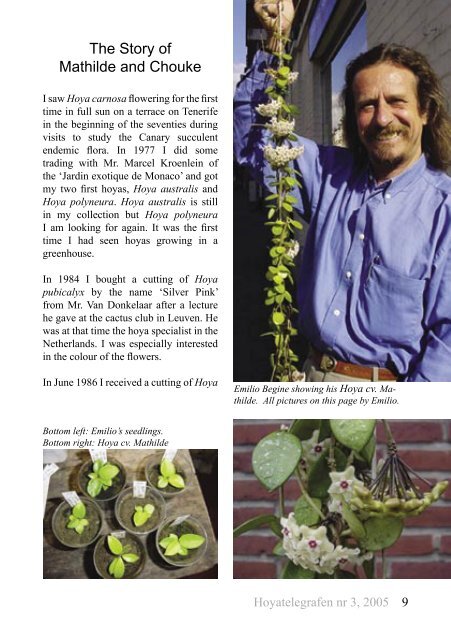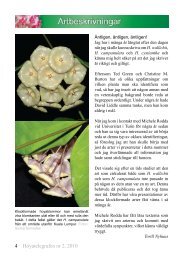The Story of Mathilde and Chouke - Swedish Hoya Society
The Story of Mathilde and Chouke - Swedish Hoya Society
The Story of Mathilde and Chouke - Swedish Hoya Society
You also want an ePaper? Increase the reach of your titles
YUMPU automatically turns print PDFs into web optimized ePapers that Google loves.
<strong>The</strong> <strong>Story</strong> <strong>of</strong><br />
<strong>Mathilde</strong> <strong>and</strong> <strong>Chouke</strong><br />
I saw <strong>Hoya</strong> carnosa flowering for the first<br />
time in full sun on a terrace on Tenerife<br />
in the beginning <strong>of</strong> the seventies during<br />
visits to study the Canary succulent<br />
endemic flora. In 1977 I did some<br />
trading with Mr. Marcel Kroenlein <strong>of</strong><br />
the ‘Jardin exotique de Monaco’ <strong>and</strong> got<br />
my two first hoyas, <strong>Hoya</strong> australis <strong>and</strong><br />
<strong>Hoya</strong> polyneura. <strong>Hoya</strong> australis is still<br />
in my collection but <strong>Hoya</strong> polyneura<br />
I am looking for again. It was the first<br />
time I had seen hoyas growing in a<br />
greenhouse.<br />
In 1984 I bought a cutting <strong>of</strong> <strong>Hoya</strong><br />
pubicalyx by the name ‘Silver Pink’<br />
from Mr. Van Donkelaar after a lecture<br />
he gave at the cactus club in Leuven. He<br />
was at that time the hoya specialist in the<br />
Netherl<strong>and</strong>s. I was especially interested<br />
in the colour <strong>of</strong> the flowers.<br />
In June 1986 I received a cutting <strong>of</strong> <strong>Hoya</strong><br />
Bottom left: Emilio’s seedlings.<br />
Bottom right: <strong>Hoya</strong> cv. <strong>Mathilde</strong><br />
Emilio Begine showing his <strong>Hoya</strong> cv. <strong>Mathilde</strong>.<br />
All pictures on this page by Emilio.<br />
<strong>Hoya</strong>telegrafen nr 3, 2005 9
<strong>Hoya</strong> carnosa <strong>Mathilde</strong><br />
<strong>Hoya</strong> serpens<br />
serpens from Mr. Pol Bourdoux <strong>and</strong> that<br />
plant flowered for me for the first time in<br />
1988. I was surprised by the small leaves<br />
<strong>and</strong> interested in growing it, because<br />
the flowers smelled so nice. In 1989 I<br />
took some cuttings from that plant for<br />
exchanges <strong>and</strong> got the first seed pods. I<br />
have to mention that up until 2003 I had<br />
to move my plant collection twice a year.<br />
In the spring I brought them outside or<br />
under a ro<strong>of</strong> <strong>of</strong> corrugated plastic. In the<br />
winter I brought them inside placing them<br />
all over the house <strong>and</strong> in the basement.<br />
In 1992 my <strong>Hoya</strong> serpens gave me no<br />
less than 6 seed pods. In 1994 when I got<br />
flowers on my <strong>Hoya</strong> pubicalyx <strong>and</strong> my<br />
<strong>Hoya</strong> australis. I became more interested<br />
<strong>and</strong> I bought a book about hoyas from<br />
Robert Dale Kloppenburg.<br />
<strong>The</strong> same summer I had both <strong>Hoya</strong><br />
serpens <strong>and</strong> <strong>Hoya</strong> carnosa flowering at<br />
the same time <strong>and</strong> I discovered my first<br />
(<strong>and</strong> still unique) seed pod on my <strong>Hoya</strong><br />
carnosa. I was not thinking about a<br />
cross at that time as all the <strong>Hoya</strong> serpens<br />
seedlings look exactly like <strong>Hoya</strong> serpens,<br />
but I was curious anyway. <strong>The</strong> seedpod<br />
split open in January 1995 <strong>and</strong> I collected<br />
10 <strong>Hoya</strong>telegrafen nr 3, 2005<br />
a few seeds that I sowed in a terrarium in<br />
October the same year.<br />
In June 1997 I had only two seedlings<br />
left. I repotted them <strong>and</strong> I was surprised<br />
that the leaves did not grow as big as their<br />
mother <strong>Hoya</strong> carnosa. I took a cutting <strong>of</strong><br />
both for safety’s sake <strong>and</strong> waited to see<br />
the flowers. I had the first ones in 2000<br />
<strong>and</strong> discovered that both plants had some<br />
differences in leaves, flowers <strong>and</strong> smell.<br />
<strong>The</strong> nicest one for me is ‘<strong>Mathilde</strong>’ in<br />
all aspects. I first gave them the name<br />
<strong>Hoya</strong> carnosa x serpens with a different<br />
clone number (BE 23 <strong>and</strong> BE 24), but<br />
some people in a discussion group under<br />
Yahoo asked me why I didn’t give them a<br />
proper name. So I did in 2003 – <strong>Mathilde</strong><br />
is after one <strong>of</strong> our princesses <strong>and</strong> <strong>Chouke</strong><br />
is the name I used for my wife till she<br />
died in 2002. So both cultivars were<br />
accidentally born, but lovely <strong>and</strong> very<br />
easy houseplants. You have to smell<br />
them <strong>and</strong> taste their nectar.<br />
Now I only hope that some day I will<br />
be able to make a cross between <strong>Hoya</strong><br />
pubicalyx ‘Red Buttons’ <strong>and</strong> <strong>Hoya</strong><br />
serpens <strong>and</strong> see the results.<br />
Emilio Begine<br />
Photo: Emilio Begine
<strong>Hoya</strong> cv. <strong>Mathilde</strong> to the left <strong>and</strong><br />
<strong>Hoya</strong> cv. <strong>Chouke</strong> to the right<br />
<strong>Hoya</strong> cv. <strong>Mathilde</strong>, photo: Emilio Begine<br />
<strong>Hoya</strong> cv. <strong>Chouke</strong>, photo: Emilio Begine<br />
<strong>Hoya</strong> cv. <strong>Mathilde</strong>, photo: Eva-Karin Wiberg<br />
<strong>Hoya</strong>telegrafen nr 3, 2005 11
<strong>Hoya</strong> cv. <strong>Mathilde</strong> Photo: Birgitta Hellström<br />
Facts about <strong>Hoya</strong> cv. <strong>Mathilde</strong><br />
Colour: White corolla, white corona<br />
with a red centre<br />
Flowershape: Flat<br />
Flowersize: 2 cm<br />
Umbel: Hanging down, convex<br />
Number <strong>of</strong> flowers: 15-20<br />
Durability: 5-7 days<br />
Time <strong>of</strong> flowering: All year around<br />
How I grow <strong>Hoya</strong> cv. <strong>Mathilde</strong><br />
In the Spring <strong>of</strong> 2004 I went to Holl<strong>and</strong><br />
<strong>and</strong> visited Paul Shirley to buy cuttings.<br />
<strong>Hoya</strong> cv. <strong>Mathilde</strong> was one <strong>of</strong> the them<br />
who came home unrooted <strong>and</strong> with 6<br />
pairs <strong>of</strong> leaves.<br />
Since then it has grown in a small 4 cm<br />
pot on a shelf under artificial lights. <strong>The</strong><br />
plants get 16 hours <strong>of</strong> artificial light<br />
since the shelves are downstairs in my<br />
recreation room. <strong>The</strong> plant has grown<br />
well <strong>and</strong> started flowering in March.<br />
12 <strong>Hoya</strong>telegrafen nr 3, 2005<br />
Peduncle: Perennial<br />
Scent: Sweet<br />
Nectar: Yes, a little<br />
Leaves: 3 cm long, 2 cm wide<br />
Stem: 1,5 mm<br />
Growth: Twining<br />
Best place: Light placing<br />
Temperature: Around 22 degrees C<br />
Until today it has flowered twice, but<br />
when I was going to take a photo I broke<br />
<strong>of</strong>f a stem. (grrrr).<br />
When you have small plants in small<br />
pots under artificial lights you have to<br />
water very <strong>of</strong>ten <strong>and</strong> a lot, not my strong<br />
side, but growing <strong>Hoya</strong> cv. <strong>Mathilde</strong> has<br />
been OK. <strong>The</strong> plant itself is very pretty<br />
with small dark green leaves with a lot <strong>of</strong><br />
silver speckling. <strong>The</strong> fact that the umbel<br />
was bigger than the leaves was a nice<br />
surprise.<br />
Birgitta Hellström
<strong>Hoya</strong> cv. <strong>Chouke</strong><br />
Facts about <strong>Hoya</strong> cv. <strong>Chouke</strong><br />
Colour: White corolla, white corona<br />
with a pink centre<br />
Flowershape: Flat<br />
Flowersize: 2 cm<br />
Umbel: Hanging down, convex<br />
Number <strong>of</strong> flowers: 15-20<br />
Durability: 5-7 days<br />
Time <strong>of</strong> flowering: All year around<br />
How I grow <strong>Hoya</strong> cv. <strong>Chouke</strong><br />
I bought <strong>Hoya</strong> cv. <strong>Chouke</strong> in the Autumn<br />
<strong>of</strong> 2003 as an unrooted cutting. I planted<br />
it in a small pot <strong>and</strong> put it on shelves<br />
under artificial light. It took some time to<br />
start growing but now it’s has increased<br />
in speed.<br />
<strong>The</strong> leaves resembles those <strong>of</strong> <strong>Hoya</strong> cv.<br />
Peduncle: Perennial<br />
Scent: Sweet<br />
Nectar: Yes, a little<br />
Leaves: 5 cm long, 3 cm wide<br />
Stem: 2 mm<br />
Growth: Twining<br />
Best place: Light placing<br />
Temperature: Around 22 degrees C<br />
<strong>Mathilde</strong>, but they have a bit more pointed<br />
tips. I take this as if it has inherited more<br />
from it’s mother <strong>Hoya</strong> carnosa.<br />
With the space situation being very<br />
crowded in my house I will soon put it in<br />
a hanging pot.<br />
Carin Wahlström<br />
<strong>Hoya</strong>telegrafen nr 3, 2005 13<br />
Photo: Emilio Begine



